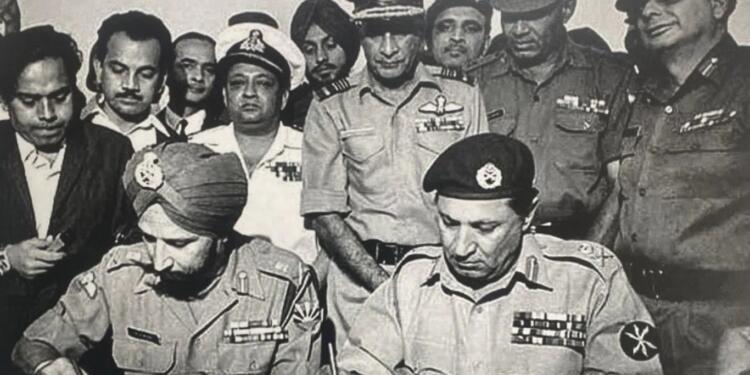December 16, 1971, was the date when a historic military victory established Bangladesh as a nation and placed India firmly in the saddle of peace, justice, and democracy. This is because the war that lasted only for 13 days was a defining moment in the history of South Asia when the Indian Armed Forces, along with the Mukti Bahini freedom fighters, delivered the final blow to the invading Pakistani forces. This was at a huge cost and marked the exemplary sacrifices of soldiers and strategic excellence in military operations. The saying freedom isn’t free indeed strikes deep while contemplating the sacrifice in the 1971 India-Pakistan War.
In the twilight hour before this milestone, the Vijay Diwas Reception was organized at Army House in New Delhi under the aegis of Chief of Army Staff (COAS) General Upendra Dwivedi and wife Smt. Sunita Dwivedi. The event was graced by the Hon’ble President of India, Droupadi Murmu; the Hon’ble Vice President of India, Shri Jagdeep Dhankhar; and Raksha Mantri Shri Rajnath Singh. Through this commemoration, a blend of veterans, Veer Naris, members from the diplomatic community, sportspersons, tribal artists, and Asha schoolchildren came together to reflect a sense of remembrance, gratitude, and gaiety with respect for sacrifice.

Indian Army on a post on X shared a glimpse of the celebrations.
#VijayDiwas Reception
Hon’ble President of #India Droupadi Murmu graced the #VijayDiwas Reception, organised on the eve of #VijayDiwas at #ArmyHouse, to commemorate the victory of the #IndianArmedForces during the India-Pakistan War of 1971.
The reception provided an… pic.twitter.com/NH35Ra1Jac
— ADG PI – INDIAN ARMY (@adgpi) December 16, 2024
On the occasion of Vijay Diwas, Raksha Mantri Shri @rajnathsingh paid homage to our brave soldiers and laid a wreath at the #NationalWarMemorial, New Delhi, today. The day marks the splendid victory of our #ArmedForces during the #1971War. pic.twitter.com/4r0dQ67t79
— Ministry of Defence, Government of India (@SpokespersonMoD) December 16, 2024
The Ministry of Defence also shared a post on X.
 During the reception, an iconic 1971 painting — when Indian Forces materialised the surrender of around 93,000 Pakistani soldiers — was installed at the Manekshaw Centre, named after Field Marshal Sam Manekshaw, the architect of the war strategy leading to India’s victory. This iconic piece of art remains a standing testament to the strategic thinking of the Indian Armed Forces, sacrifices by soldiers, and the fight for liberty and justice.
During the reception, an iconic 1971 painting — when Indian Forces materialised the surrender of around 93,000 Pakistani soldiers — was installed at the Manekshaw Centre, named after Field Marshal Sam Manekshaw, the architect of the war strategy leading to India’s victory. This iconic piece of art remains a standing testament to the strategic thinking of the Indian Armed Forces, sacrifices by soldiers, and the fight for liberty and justice.
#VijayDiwas Reception
Hon’ble Vice President of #India Shri Jagdeep Dhankhar attended the #VijayDiwas Reception hosted by #GeneralUpendraDwivedi, #COAS, at #ArmyHouse on the eve of #VijayDiwas. This ceremonial event paid tribute to the heroic triumph of #IndianArmedForces… pic.twitter.com/wEYrRHs8j8
— ADG PI – INDIAN ARMY (@adgpi) December 16, 2024
1971 India-Pakistan War
The India-Pakistan War of 1971 was more than a military conflict; it was more of a fight to end oppression that paved the way for the founding of Bangladesh as an independent sovereign nation. In short, the roots of conflict go deep into how East Pakistan fought against political and social inequality under the dominance of West Pakistan. India was well dug in, supporting the freedom-fighting Mukti Bahini, who took military operations to war with full force.
On December 3, 1971, in a preemptive action, the Pakistani military launched Operation Chengiz Khan by attacking the Indian airbases with intent to cripple the Indian military forces. It was the first aggressive military operation carried out by Pakistan in this conflict; however, India responded sharply.
Major Military Operations: Battles on Land, Sea, and Air
It consisted of joint air, naval, and land attacks that crippled Pakistan’s military system and provided for a victory on the battlefield for India. Indian military campaigns crossed the two fronts of western and eastern fronts, with many notable campaigns:
Advances of Pakistani Forces toward Jaisalmer: Pakistan made an effort to push its western front by advancing towards Jaisalmer. However, the Indian forces launched strategic counterattacks that stopped their advance.
The Battle of Ghazipur & Basantar: It was the weakening of Pakistani forward positions due to the Battle of Ghazipur and the Battle of Basantar that included the major ground operations.
Dera Baba Nanak Battle: Fought in Gurdaspur district in Punjab, this was the other key encounter where Indian forces had proved strategic military superiority.
While India continued to concentrate on its military operation in East Pakistan, the Indian Navy initiated Operation Trident on December 8, 1971. This naval operation attacked Pakistan’s major port city, Karachi. Indian warships inflicted serious damage on Pakistani naval and logistical assets, which crippled their capability to wage war even further.
Despite all the hardship, the Meghna River was successfully crossed by Indian troops on December 9. Indian troops were able to gain ground in key areas of East Pakistan thanks to this crucial river crossing, which guaranteed that their advance toward Dhaka would continue to gain momentum.
Air Strikes and Ground Advances
On 10 December, the Indian Air Force attacked the Pakistani military infrastructure with a major aerial assault on the Chittagong airbase in Bangladesh. This strategic airstrike hindered the operational mobility of Pakistani forces and severely weakened the capacity of Pakistani forces to repel Indian advances. The success of this operation had sealed India’s dominance in the air, which helped the Indian Armed Forces breach key areas of East Pakistan.
Also Read: JFR Jacob: The Indian who masterminded the fall of Dhaka
On 11 December, Indian troops successfully airdropped the 2nd Para Battalion at Tangail. This was one of the airdropping operations that showcased India’s logistical capabilities and ability to accurately project force into the relevant areas with speed. This helped the 2nd Para Battalion to deploy safely and provide critical support to advancing Indian troops.
The Indian military operations picked up speed between December 12 and December 16 as it advanced into the capital of East Pakistan, Dhaka. The Indian forces, assisted by naval and aerial supremacy, advanced with strategic precision as they entered Dhaka on December 16, thus itching the day as Vijay Diwas.
The Final Surrender and Birth of Bangladesh
On 16 December 1971 afternoon, Lieutenant General A.A.K. Niazi, the military commander of Pakistan in East Pakistan, formally signed the Instrument of Surrender in Dhaka. It was a monumental event ending the war of 1971, wherein 93,000 Pakistani troops surrendered to the Lieutenant-General Jagjit Singh Aurora, leading the Indian forces, and the Mukti Bahini. It was one of the largest surrenders in military history, and it symbolized the end of the war.
This was a momentous day that brought Bangladesh to birth. It fulfilled the dreams of millions of East Pakistanis fighting for freedom. It was not a victory for India as a military but as a declaration of her determination to stand for justice, equality, and democracy in the face of oppression.
This Vijay Diwas, as the country commemorates the military’s strategic genius and sacrifices, is an occasion to honor the fallen, celebrate peace, and fortify our determination to stand by those who defend our independence.
Jai Hind!































